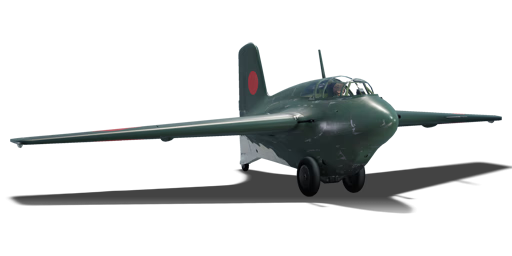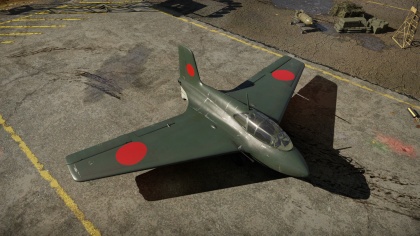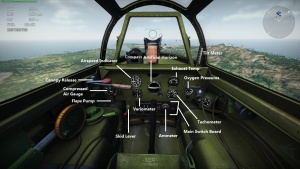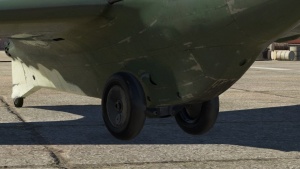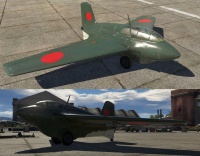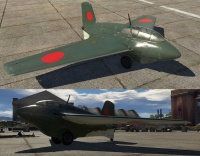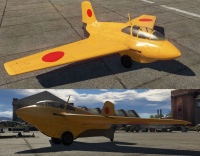Difference between revisions of "Ki-200"
Inceptor57 (talk | contribs) (Bugs/data discrepancies should be taken to their appropriate sections on the forums) |
(→Flight performance) (Tag: Visual edit) |
||
| Line 18: | Line 18: | ||
== General info == | == General info == | ||
=== Flight performance === | === Flight performance === | ||
| − | ''Describe how the aircraft behaves in the air. Speed, manoeuvrability, acceleration and allowable loads - these are the most important characteristics of the plane.'' | + | <!-- ''Describe how the aircraft behaves in the air. Speed, manoeuvrability, acceleration and allowable loads - these are the most important characteristics of the plane.'' --> |
{| class="wikitable" style="text-align:center" | {| class="wikitable" style="text-align:center" | ||
Revision as of 20:39, 13 September 2020
Contents
Description
The Ki-200 Shusui is a rank V Japanese jet fighter
with a battle rating of 9.3 (AB), 8.7 (RB), and 8.0 (SB). It has been in the game since the start of the Open Beta Test prior to Update 1.27.
As a rocket, you are the fastest accelerating plane in this bracket. Some of the most common enemies you will face are MiG-17s, MiG-15s (and MiG-15bis's), CL-13s, La-15s, Me 163 B's, Yak-30s as well as bombers such as the Tu-4, the Tu-14T and the IL-28. For the most part, you have incredible advantages over anything you will face. The main downfall of the Ki-200 is that it only has 5 minutes of fuel. Because of this, fights cannot last long periods of time and you must always be aware of the closest airfield location.
Another issue of the Ki-200 is that the wings are very fragile. Any sort of hard turn while at high speed will result in your wings being brutally ripped apart from wing overload.
People often don't know what to do with the Ki-200 at the start of a match. You can choose to climb, which is time-consuming and uses fuel, or glide at low altitude with a low throttle to save fuel for combat, or you can, race full-throttle towards the enemy. By doing this, you can often catch unknowing enemy aircraft climbing.
Once again, do not try to pull more than 8G's in a turn fight at speeds exceeding 720 km/h (450 mph). If you want to turn or manoeuvre quicker, throttle down and jiggle your rudder or slowly face the nose of the plane upwards so it slows down. By doing this, you can almost certainly avoid ripping your wings.
General info
Flight performance
| Characteristics | Max Speed (km/h at 10,000 m) |
Max altitude (metres) |
Turn time (seconds) |
Rate of climb (metres/second) |
Take-off run (metres) | |||
|---|---|---|---|---|---|---|---|---|
| AB | RB | AB | RB | AB | RB | |||
| Stock | 983 | 973 | 14900 | 17.2 | 17.3 | 37.9 | 35.2 | 850 |
| Upgraded | 1,005 | 995 | 16.8 | 17.0 | 56.3 | 47.4 | ||
Details
| Features | |||||
|---|---|---|---|---|---|
| Combat flaps | Take-off flaps | Landing flaps | Air brakes | Arrestor gear | Drogue chute |
| ✓ | X | ✓ | X | X | X |
| Limits | ||||||
|---|---|---|---|---|---|---|
| Wings (km/h) | Gear (km/h) | Flaps (km/h) | Max Static G | |||
| Combat | Take-off | Landing | + | - | ||
| 1040 | 550 | 620 | N/A | 420 | ~9 | ~4 |
| Optimal velocities (km/h) | |||
|---|---|---|---|
| Ailerons | Rudder | Elevators | Radiator |
| < 790 | < 600 | < 690 | N/A |
Engine performance
| Engine | Aircraft mass | ||||
|---|---|---|---|---|---|
| Engine name | Number | Empty mass | Wing loading (full fuel) | ||
| Toko Ro.2 | 1 | 1,610 kg | 209 kg/m2 | ||
| Engine characteristics | Mass with fuel (no weapons load) | Max Takeoff Weight | |||
| Weight (each) | Type | 1m fuel | 5m fuel | ||
| 166 kg | Liquid-fuel rocket | 2,016 kg | 3,640 kg | 4,000 kg | |
| Maximum engine thrust @ 0 m (RB / SB) | Thrust to weight ratio @ 0 m (100%) | ||||
| Condition | 100% | WEP | 1m fuel | 5m fuel | MTOW |
| Stationary | 1,700 kgf | N/A | 0.84 | 0.47 | 0.43 |
| Optimal | 1,700 kgf (any speed) |
N/A | 0.84 | 0.47 | 0.43 |
Survivability and armour
- 70 mm Bulletproof glass - Armored windscreen
- 13 mm Steel plate behind the pilot
Armaments
Offensive armament
The Ki-200 is armed with:
- 2 x 30 mm Ho-155 army cannons, wing-mounted (60 rpg = 120 total)
Usage in battles
Dogfighting
Some of the aircraft you will face while flying the Ki-200 are the top tier jets such as the MiG-17 and the MiG-15/MiG-15bis. Like a rocket, you have an almost unprecedented advantage over all of these aircraft. The Ki-200 has an astounding climb rate rivalling that of the MiG-15. Due to this, you can choose when and where you want to engage enemy aircraft. Having this is the most important advantage one can have whilst flying the Ki-200. Once you lose this ability, you are likely to be destroyed. An example of this would be when you are almost out of fuel and/or ammunition and are forced to land.
Another huge advantage you have over jet and prop aircraft is your ability to turn. The Ki-200 can virtually turn on a dime, allowing you to even out turn propeller aircraft. However, if you try to turn too hard at high speeds, pulling more than 8 G's, your wings will snap, resulting in a crash. The perfect time to turn is around 600 km/h. Here, you can pop out your flaps - making the Ki-200 feel like a tiny Zero.
The main points:
- Watch your fuel
- Watch your speeds when turning/diving
- Have situational awareness
- Decide the terms of attack
- Know how to save and spend fuel
The Ki-200's armament consists of 2 x Type-5 30 mm cannons. The Ki-200 only has 120 rounds of ammunition so it is essential you hit your target accurately. For this, it is not recommended to attempt making deflection shots. It is very easy to get up close with an enemy and kill it with usually less than 20 rounds. That being said, learning how to lead for long-range shots is unnecessary while flying the Ki-200. However, you may come upon situations in which you are following an enemy jet and can't close the distance. In those situations, it is very helpful to know how to deliver 30 mm shells at a longer distance. Usually, it is not difficult to hit those shots, but it can become aggravating due to the cannons jerking left and right from recoil. It is advisable against long, arduous engagements (e.g. following an F-80 and not being able to close the distance) because you waste too much fuel and risk not being able to return to an airfield even if you destroy your opponent.
Taking off and Managing fuel
The Ki-200 is fitted with a disposable gear just like the Me-163 when spawning or respawning on an airfield, it will automatically drop to the ground once you have taken off. When taking off in RB/SB, the speed in which you start to leave the ground is at 230 km/h (140 mph) with fully extended flaps and 300 km/h (185 mph) with the flaps fully retracted.
Managing fuel consumption is very important since the fuel burns out after 5 minutes at full throttle. The lifetime of your fuel increases by more than 15 times below 30% throttle while still maintaining good enough speed. It is strongly advised to keep your throttle low when loitering at high altitude or flying back to base with few seconds of fuel left. You can still get back to base with just 10 seconds of fuel and with the decent speed at 20% throttle which will make it last around 3 minutes longer. Generally, it is advised to zoom climb up to altitude and build up whatever speed you can before your fuel indicator hits 3:30. At that point, throttle back to 50% and hunt for an enemy. In a dogfight, use full throttle, but if you cannot catch someone or the fight will be over their airfield pull off, climb, and idle until another opportunity presents itself.
| Throttle efficiency
(horizontal flight at sea level, RB/SB) | |||
|---|---|---|---|
| Throttle (%) | Highest Maintainable Speed | Fuel Lifetime (full tank) | Flight Distance |
| 100 | 959 km/h (596 mph) | 5 minutes | ~80 km / 50 mi |
| 75 | 890 km/h (553 mph) | ~10 minutes (2x) | ~148 km / 92 mi |
| 50 | 758 km/h (471 mph) | ~20 minutes (4x) | ~253 km / 157 mi |
| 25 | 563 km/h (350 mph) | ~80 minutes (16x) | ~750 km / 466 mi |
Setting the throttle to 0% is very likely to cause fuel starvation and shut down the engine which makes the aircraft decelerate faster, increase throttle with at least 1% and it will turn right back on.
Manoeuvring and Landing
To fully master the Ki-200, it is important to learn how to manoeuvre and land effectively. It is strongly advised, against vertical manoeuvres in the Ki-200. Even if you are at speeds under 720 km/h (450 mph) it becomes very easy to rip your wings in vertical dives. That being said, do not try to quickly nose up after any sort of vertical manoeuvre. Come back to your old buddy the horizontal turn. You may think because the Ki-200 is a rank V aircraft, it must be bad at turning, but that is simply not the case. The Ki-200 is a blend between a Zero, a MiG-15, and a Sabre. It turns like nothing, has an incredible climb rate, and can reach very high top speeds.
In order to land with the Ki-200, you must come into the runway on a slow approach. The Ki-200 has gear and landing flaps, but I would only recommend using the gear to lose airspeed coming into the landing. If you hit the runway too hard with the gear down, the plane goes into an up and down motion sort of like there are imaginary hills on the runway. Belly landings are much more efficient not only because you avoid the derp, but because the aircraft will slow down incredibly quickly, however, there's a possibility your pilot will get knocked unconscious if you are not careful enough with your landing. In general, land it like a prop plane but without landing gear. It is possible to land on aircraft carriers although it requires some skill. You have to come in extremely slow and without gear. Essentially, you want to hit the deck with as little speed as possible so you stop without knocking the pilot unconscious. It is recommended to try to land at speeds no less than 210 km/h (130 mph).
Bomber Hunting
Flying the Japanese at late tier 4 or early tier 5 you often have a mixture of Ki-200 (the dog-fighters), R2Y2 (the bomber killers) and various props which are hybrids. Due to the lack of ammo in the Ki-200, it is not recommended to go after bombers unless they are the only planes left on the enemy team. You simply waste too much ammo for too little a reward. The R2Y2 is much more suited for bomber killing as it has 4 x 30 mm cannons with plenty of ammunition. However, if you do decide to engage a bomber it is advised to attack from above and behind where you can get easy shots on the bomber's wing roots and fuselage. You may also come straight down and aim for the wings. Once again, be careful pulling up from the dive. Some common bombers you may face are the Tu-4, S.O.4050, Tu-14T and IL-28. Although mostly defenceless they are extremely fast. It is recommended attacking them head-on if they are at their top speed. Otherwise, they are very hard to catch even with the Ki-200.
Manual Engine Control
| MEC elements | ||||||
|---|---|---|---|---|---|---|
| Mixer | Pitch | Radiator | Supercharger | Turbocharger | ||
| Oil | Water | Type | ||||
| Not controllable | Not controllable Not auto controlled |
Not controllable Not auto controlled |
Not controllable Not auto controlled |
Combined | Not controllable 1 gear |
Not controllable |
Modules
| Tier | Flight performance | Survivability | Weaponry |
|---|---|---|---|
| I | Fuselage repair | Offensive 30 mm | |
| II | Airframe | ||
| III | Wings repair | New 30 mm cannons | |
| IV | Engine | Cover |
Pros and cons
Pros:
- High top speed
- Fast turning
- Extremely good acceleration
- Good climb rate
- Good glide characteristics
Cons:
- Low ammunition count
- Largely unreliable guns
- Low fuel capacity
- Fuel runs out very fast since it uses a rocket engine
- Weak wings, susceptible to snapping
History
Describe the history of the creation and combat usage of the aircraft in more detail than in the introduction. If the historical reference turns out to be too long, take it to a separate article, taking a link to the article about the plane and adding a block "/ History" (example: https://wiki.warthunder.com/(plane-name)/History) and add a link to it here using the main template. Be sure to reference text and sources by using <ref></ref>, as well as adding them at the end of the article with <references />. This section may also include the plane's dev blog entry (if applicable) and the in-game encyclopedia description (under === In-game description ===, also if applicable).
In-game description
Mitsubishi Shusui (Swinging Sword, no reporting name) Experimental Single-seat, Single-engine Rocket-powered Fighter, meeting specification 19-Shi; Navy designation: Mitsubishi 19-Shi J8M1 (no reporting name); Army designation: Mitsubishi Ki-200 Shusui (no reporting name)
When American Boeing B-29 Superfortresses began to raid the islands of the Empire on a mass scale, the need to create a high-speed, fast-climbing, powerfully armed interceptor became ever more pressing for the Japanese aircraft industry. The Japanese, however, completely lacked experience in creating aircraft of such a class, and some initial work in this field had no effect on the bombing's intensity, since the interceptors available to the Army and the Navy were inadequate.
As usual, help came from Germany. In the autumn of 1943, at Oldenburg Air Base proving ground, Japanese military attachés were presented with a new miracle weapon, the Messerschmitt Me.163 Komet rocket-powered fighter. Its capabilities greatly impressed the Japanese. After brief negotiations, a license to produce the aircraft was purchased for 20 million Reichsmarks. As early as April 1944, a package of documents was dispatched on two Japanese submarines bound for Singapore. Some things were shipped together with the documents, such as a functional Walter HWK 109-509 rocket engine, an airframe, a number of production assemblies, and equipment components. Things did not turn out too well: one of the submarines was lost on the way after being spotted by the Allies. However, the main body of the documents was able to reach the 1st Naval Air Technical Arsenal in Yokosuka.
Unfortunately, the Japanese industry was not ready to manufacture a product of such advanced technology. Changes still had to be made, although it had been decided to stick to the documents received from the Germans as closely as possible. The main reason for the difficulties was the poor strength standards the Japanese had for the materials used. The Japanese metallurgical industry was not able to provide the high-strength alloy steels to manufacture the engine injectors, and the chemical industry could not provide the required amount of hydrogen peroxide as an oxidizer and hydrazine hydrate as a fuel. The development of the interceptor, which Mitsubishi specialists delved into as early as late June of 1944, was significantly drawn out. It was necessary, first of all, to modify the design to match the overall technological level of development of the Japanese aircraft industry.
In addition to technological problems, the designers were faced with purely technical difficulties. They needed to install some powerful armament, such as two 30mm Type 5 cannons that were larger in size than their German counterparts, the Rheinmetall-Borsig MK 108 cannons. In addition, the Walter HWK 109-509 engine produced by Mitsubishi under the designation Toko Ro.2 or KR10 was extremely accident-prone and thus dangerous. The engines regularly exploded during trial starts, killing one engineer after another. It should be noted that military specialists from both the Navy and the Army took an interest in the interceptor at the same time, but, despite the competition, the development was a joint venture. The Navy designated the project as the J8M1, whereas the Army's specialists designated it as the Ki-200, and the aircraft had a common name: the Shusui (Swinging Sword). Nevertheless, it was the engine-related problems that made the developers divide again into Army and Navy. As a result, the Army's specialists managed to assure the engine’s stable operation for 4 minutes, while the Navy's engineers achieved nothing more than 3 minutes.
On July 7, 1945, the test pilot Toyohiko Inuzuka flew the J8M1 interceptor for the first time. After the aircraft reached a height of 380 m, the engine stopped abruptly; the pilot managed to level the plane out and head back on a return course, but the situation could not be saved: the machine nosed over and was completely destroyed; the pilot died the next day from injuries sustained in the fall. Several more engine-related accidents resulted in the designers having only one KR10 left, but they failed to install it on any of the four finished J8M1 airframes because the war ended, and the project with it. By this time, the factory in Okha had 6 more airframes in different stages of preparation, 6 finished engines, and 20 more on the production line. Thus, the Japanese never managed to improve the aircraft to any flyable condition.
Media
Excellent additions to the article would be video guides, screenshots from the game, and photos.
Camouflages
^ (This historical camouflage was recreated and published by user "Sick2day")
See also
External links
Paste links to sources and external resources, such as:
- topic on the official game forum;
- encyclopedia page on the aircraft;
- other literature.
| Mitsubishi Company (三菱商会) | |
|---|---|
| Fighters | A5M4 · Hagiri's A5M4 |
| A6M2 mod. 11 · A6M2 · A6M3 · A6M3 mod. 22 · A6M3 mod. 22Ko · A6M5 · A6M5 Ko · A6M5 otsu · A6M5 Hei · A6M6c | |
| A7M1 (NK9H) · A7M2 | |
| J2M2 · J2M3 · J2M4 Kai · J2M5 · J2M5 (30 mm) | |
| Hydroplanes | F1M2 |
| Interceptors | Ki-83 · Ki-109 |
| Bombers | G4M1 |
| Ki-21-Ia · Ki-21-I hei · Ki-67-I Ko · Ki-67-I otsu | |
| Jet Fighters | Ki-200 |
| Captured | ▃A6M2 · ␗A6M2 |
| See also | Mitsubishi Heavy Industries, Ltd. (Post-War) |
| Japan jet aircraft | |
|---|---|
| IJNAS | |
| Experimental | Kikka |
| Reconnaissance | R2Y2 Kai V1 · R2Y2 Kai V2 · R2Y2 Kai V3 |
| IJAAS | |
| Fighters | Ki-200 |
| JASDF | |
| Fighters | F-86F-30 ▅ · F-86F-40 ▅ · F-86F-40 JASDF▅ |
| F-104J | |
| F-4EJ Phantom II · F-4EJ ADTW · F-4EJ Kai Phantom II | |
| F-15J · F-15J(M) | |
| F-16AJ | |
| F-1 | |
| Trainers | T-2 Early · T-2 |
| Foreign | |
| Thailand | ▄AV-8S · ▄F-5E FCU |


